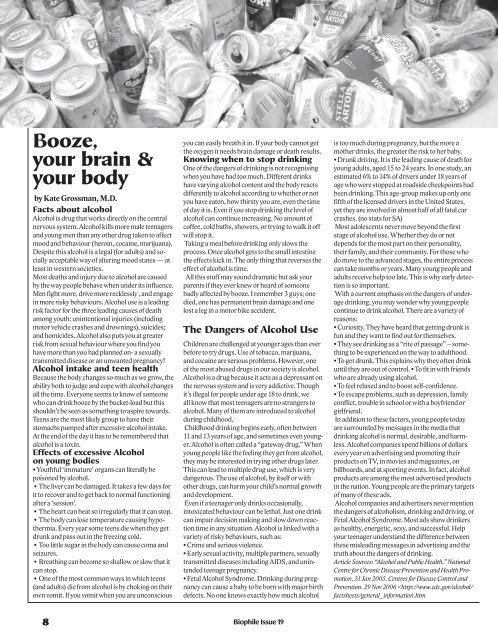BIOP HILE 19 â DEC 07/JAN 08 â R25 - Biophile Magazine
BIOP HILE 19 â DEC 07/JAN 08 â R25 - Biophile Magazine
BIOP HILE 19 â DEC 07/JAN 08 â R25 - Biophile Magazine
Create successful ePaper yourself
Turn your PDF publications into a flip-book with our unique Google optimized e-Paper software.
Booze,your brain &your bodyby Kate Grossman, M.D.Facts about alcoholAlcohol is drug that works directly on the centralnervous system. Alcohol kills more male teenagersand young men than any other drug taken to affectmood and behaviour (heroin, cocaine, marijuana).Despite this alcohol is a legal (for adults) and sociallyacceptable way of altering mood states — atleast in western societies.Most deaths and injury due to alcohol are causedby the way people behave when under its influence.Men fight more, drive more recklessly , and engagein more risky behaviours. Alcohol use is a leadingrisk factor for the three leading causes of deathamong youth: unintentional injuries (includingmotor vehicle crashes and drownings), suicides;and homicides. Alcohol also puts you at greaterrisk from sexual behaviour where you find youhave more than you had planned on- a sexuallytransmitted disease or an unwanted pregnancy!Alcohol intake and teen healthBecause the body changes so much as we grow, theability both to judge and cope with alcohol changesall the time. Everyone seems to know of someonewho can drink booze by the bucket-load but thisshouldn’t be seen as something to aspire towards.Teens are the most likely group to have theirstomachs pumped after excessive alcohol intake.At the end of the day it has to be remembered thatalcohol is a toxin.Effects of excessive Alcoholon young bodies• Youthful ‘immature’ organs can literally bepoisoned by alcohol.• The liver can be damaged. It takes a few days forit to recover and to get back to normal functioningafter a ‘session’.• The heart can beat so irregularly that it can stop.• The body can lose temperature causing hypothermia.Every year some teens die when they getdrunk and pass out in the freezing cold.• Too little sugar in the body can cause coma andseizures.• Breathing can become so shallow or slow that itcan stop.• One of the most common ways in which teens(and adults) die from alcohol is by choking on theirown vomit. If you vomit when you are unconsciousyou can easily breath it in. If your body cannot getthe oxygen it needs brain damage or death results.Knowing when to stop drinkingOne of the dangers of drinking is not recognisingwhen you have had too much. Different drinkshave varying alcohol content and the body reactsdifferently to alcohol according to whether or notyou have eaten, how thirsty you are, even the timeof day it is. Even if you stop drinking the level ofalcohol can continue increasing. No amount ofcoffee, cold baths, showers, or trying to walk it offwill stop it.Taking a meal before drinking only slows theprocess. Once alcohol gets to the small intestinethe effects kick in. The only thing that reverses theeffect of alcohol is time.All this stuff may sound dramatic but ask yourparents if they ever knew or heard of someonebadly affected by booze. I remember 3 guys; onedied, one has permanent brain damage and onelost a leg in a motor bike accident.The Dangers of Alcohol UseChildren are challenged at younger ages than everbefore to try drugs. Use of tobacco, marijuana,and cocaine are serious problems. However, oneof the most abused drugs in our society is alcohol.Alcohol is a drug because it acts as a depressant onthe nervous system and is very addictive. Thoughit’s illegal for people under age 18 to drink, weall know that most teenagers are no strangers toalcohol. Many of them are introduced to alcoholduring childhood.Childhood drinking begins early, often between11 and 13 years of age, and sometimes even younger.Alcohol is often called a “gateway drug.” Whenyoung people like the feeling they get from alcohol,they may be interested in trying other drugs later.This can lead to multiple drug use, which is verydangerous. The use of alcohol, by itself or withother drugs, can harm your child’s normal growthand development.Even if a teenager only drinks occasionally,intoxicated behaviour can be lethal. Just one drinkcan impair decision making and slow down reactiontime in any situation. Alcohol is linked with avariety of risky behaviours, such as:• Crime and serious violence.• Early sexual activity, multiple partners, sexuallytransmitted diseases including AIDS, and unintendedteenage pregnancy.• Fetal Alcohol Syndrome. Drinking during pregnancycan cause a baby to be born with major birthdefects. No one knows exactly how much alcoholis too much during pregnancy, but the more amother drinks, the greater the risk to her baby.• Drunk driving. It is the leading cause of death foryoung adults, aged 15 to 24 years. In one study, anestimated 6% to 14% of drivers under 18 years ofage who were stopped at roadside checkpoints hadbeen drinking. This age-group makes up only onefifth of the licensed drivers in the United States,yet they are involved in almost half of all fatal carcrashes. (no stats for SA)Most adolescents never move beyond the firststage of alcohol use. Whether they do or notdepends for the most part on their personality,their family, and their community. For those whodo move to the advanced stages, the entire processcan take months or years. Many young people andadults receive help too late. This is why early detectionis so important.With a current emphasis on the dangers of underagedrinking, you may wonder why young peoplecontinue to drink alcohol. There are a variety ofreasons:• Curiosity. They have heard that getting drunk isfun and they want to find out for themselves.• They see drinking as a “rite of passage” – somethingto be experienced on the way to adulthood.• To get drunk. This explains why they often drinkuntil they are out of control. • To fit in with friendswho are already using alcohol.• To feel relaxed and to boost self-confidence.• To escape problems, such as depression, familyconflict, trouble in school or with a boyfriend orgirlfriend.In addition to these factors, young people todayare surrounded by messages in the media thatdrinking alcohol is normal, desirable, and harmless.Alcohol companies spend billions of dollarsevery year on advertising and promoting theirproducts on TV, in movies and magazines, onbillboards, and at sporting events. In fact, alcoholproducts are among the most advertised productsin the nation. Young people are the primary targetsof many of these ads.Alcohol companies and advertisers never mentionthe dangers of alcoholism, drinking and driving, orFetal Alcohol Syndrome. Most ads show drinkersas healthy, energetic, sexy, and successful. Helpyour teenager understand the difference betweenthese misleading messages in advertising and thetruth about the dangers of drinking.Article Sources: “Alcohol and Public Health.” NationalCentre for Chronic Disease Prevention and Health Promotion.31 Jan 2005. Centres for Disease Control andPrevention. 29 Nov 2006
















